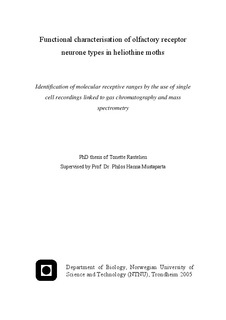| dc.contributor.author | Røstelien, Tonette | nb_NO |
| dc.date.accessioned | 2014-12-19T13:11:25Z | |
| dc.date.available | 2014-12-19T13:11:25Z | |
| dc.date.created | 2005-04-22 | nb_NO |
| dc.date.issued | 2005 | nb_NO |
| dc.identifier | 125642 | nb_NO |
| dc.identifier.isbn | 82-471-7017-5 | nb_NO |
| dc.identifier.uri | http://hdl.handle.net/11250/244629 | |
| dc.description.abstract | When the study of this thesis was initiated, hardly any work had been carried out on how plant odour information was encoded by the olfactory RNs in heliothine moths. The method of gas chromatography linked to single cell recordings (GC-SCR) was employed and improved for identifying naturally occurring plant odorants that are detected by single RNs and can be considered as biologically relevant. Three species of the subfamily Heliothinae were included in this work, the two polyphagous H. virescens and H. armigera and the oligophagous H. assulta. The American H. virescens is geographically separated from the other two species. H. armigera and H. assulta are partly sympatric in Asia and Australia.
The aims of the thesis elucidated in Papers I-IV were as follows:
1. To identify plant produced volatiles detected by antennal RNs in the three species of the subfamily Heliothinae.
2. To elucidate whether the single RNs can be classified into distinct types according to their specificity.
3. To characterise the plant odour RN types by their molecular receptive ranges, sensitivity and specificity.
4. To compare the specificity of plant odour RN types across the three related species of Heliothinae, with the aim to reveal any differences in the peripheral olfactory system that may have evolved through evolution. | nb_NO |
| dc.language | eng | nb_NO |
| dc.publisher | Fakultet for naturvitenskap og teknologi | nb_NO |
| dc.relation.ispartofseries | Doktoravhandlinger ved NTNU, 1503-8181; 2005:73 | nb_NO |
| dc.relation.haspart | Røstelien, T; Borg-Karlson, A-K; Fäldt, J; Jacobsson, U; Mustaparta, H. The Plant Sesquiterpene Germacrene D Specifically Activates a Major Type of Antennal Receptor Neuron of the Tobacco Budworm Moth Heliothis virescens. Chemical Senses. 25(2): 141-148, 2000. | nb_NO |
| dc.relation.haspart | Røstelien, T; Borg-Karlson, A-K; Mustaparta, H. Selective receptor neurone responses to E-ß-ocimene, ß-myrcene, E,E-a-farnesene and homo-farnesene in the moth Heliothis virescens, identified by gas chromatography linked to electrophysiology. Journal of Comparative Physiology A: Sensory, Neural, and Behavioral Physiology. 186(9): 833-847, 2000. | nb_NO |
| dc.relation.haspart | Stranden, M; Røstelien, T; Liblikas, I; Almaas, TJ; Borg-Karlson, A-K; Mustaparta, H. Receptor neurones in three heliothine moths responding to floral and inducible plant volatiles. Chemoecology. 13(3): 143-154, 2003. | nb_NO |
| dc.relation.haspart | Røstelien, T; Stranden, M; Borg-Karlson, A-K; Mustaparta, H. Olfactory Receptor Neurons in Two Heliothine Moth Species Responding Selectively to Aliphatic Green Leaf Volatiles, Aromatic Compounds, Monoterpenes and Sesquiterpenes of Plant Origin. Chemical Senses. 30: 443-461, 2005. | nb_NO |
| dc.subject | Biology | en_GB |
| dc.subject | NATURAL SCIENCES: Biology | en_GB |
| dc.title | Functional characterisation of olfactory receptor neurone types in heliothine moths: Identification of molecular receptive ranges by the use of single cell recordings linked to gas chromatography and mass spectrometry | nb_NO |
| dc.type | Doctoral thesis | nb_NO |
| dc.contributor.department | Norges teknisk-naturvitenskapelige universitet, Fakultet for naturvitenskap og teknologi, Institutt for biologi | nb_NO |
| dc.description.degree | PhD i biologi | nb_NO |
| dc.description.degree | PhD in Biology | en_GB |
